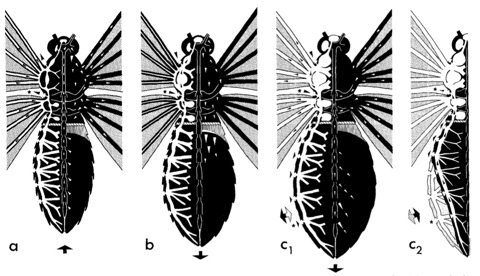Wasserthal, L.T. (1982a): Antagonism between haemolymph transport and tracheal ventilation in an insect (Attacus atlas L.). - J. Comp. Physiol. 147: 27-40.
1. The interrelations between haemolymph transport and tracheal ventilation in the wings have been analyzed in resting giant silk moths, Attacus atlas L., with respect to the oscillating haemolymph supply of the body. 2. Direction and relative intensity of haemolymph flows in the wing veins are recorded simultaneously with pulse activity of the mesotergal pulsatile organ (PO) by means of contact thermography. 3. The condition of tracheal distension and the haemolymph content in the wing veins are examined by light microscopy and scanning electron microscopy after rapid freeze fixation at specified times during the pulse periods and the pauses of the PO. 4. Haemolymph is periodically sucked out from all wing veins by the PO mainly during reverse pulse periods of the heart and is transported into the abdomen. Haemolymph returns into all wing veins after the first 10 to 25 pulses of the forward pulse period of the heart throughout the pulsation pause of the PO. 5. By removing haemolymph from the wing veins, the POs induce a compensatory increase of tracheal volume and thus bring about wing inspiration. Owing to their elasticity the wing tracheae act as antagonists to the POs, sucking haemolymph back into the wing haemocoele in the course of expiration. 6. Cross-sectional tracheal elasticity is based on coiling of the taenidia along the transverse axis of the wing tracheae which is superimposed on the normal longitudinal helical arrangement. 7. The functional advantage of haemolymph oscillation and the possible distribution of this supply mechanism in insect wings are discussed.

Supercoiling of wing tracheae in Saturniidae allows to be elastically distended. These tracheae compensate the reduced haemocoelic volume and function as antagonists to the sucking muscle organs (abdomen, heart and tergal organs) to resuck haemolymph back into the blindly ending wing veins. Other Lepidoptera have different plication patterns.

